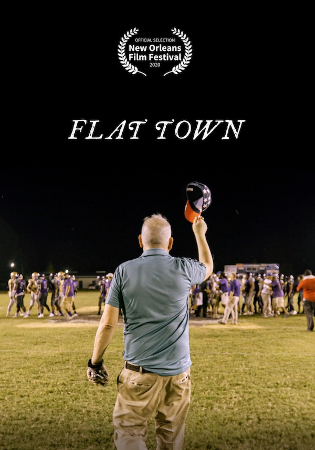
Flat Town 2020
Distributed by The Video Project, 145 - 9th St., Suite 230, San Francisco, CA 94103; 800-475-2638
Produced by Gavin P. Sullivan
Directed by Bryan Tucker
Streaming, 30 mins
College - General Adult
Education; Race Relations
Date Entered: 07/21/2021
Reviewed by Russell A. Hall, Reference and Instruction Librarian, Penn State ErieFlat Town is nominally the story of a yearly high school football game in Ville Platte, Louisiana (Flat Town is the nickname and English translation of the town’s name). However, the annual football game between the public Ville Platte High School and the private Catholic high school, Sacred Heart, is only the launching point for an investigation of race relations in Ville Platte. Over the years the game has become a tradition for this impoverished small town. Dubbed the Tee Cotton Bowl, many of the interviewees in the film regard the importance of the game as a chance for the Black and white communities of Ville Platte to come together and mingle, therefore making a step forward every year in race relations in the town.
The filmmakers gently interrogate this idea by interviewing Ville Platte both Black and white citizens of Ville Platte. A central question the viewer might ask is why would a football game have anything to do with bringing these communities together. Larry Moore, a teacher at Ville Platte High School who is African-American, states that outsiders might ask why but, “sometimes I don’t believe the why is important at the moment. Let’s have the game, enjoy it, and keep moving. I do believe if you ask why and you really start digging, you’re going to get answers that’s going to pull up more things that you don’t really want to pull up.” Flat Town ignores this admonition and digs into the “why.” At least one of the answers lies in that Sacred Heart’s student population is 95% white and Ville Platte High School’s student population is 60% Black/PoC. The value of the film stems from this demographic fact. From here the Flat Town presents a short but compelling history of the aftermath school desegregation and de facto re-segregation in Ville Platte.
The filmmakers report that in the 1960s and 70s, the white families who could afford it sent their school-age children to a private school in a nearby town to avoid having their children go to school with African-American children. After the out-of-town school closed, these families and others like them sent their children to Sacred Heart, essentially making it a de facto segregation academy. Mayor Jennifer Vidrine, the first African-American and first female mayor in the town’s history, believes that the game brings the two schools together as does the founder of the Tee Cotton Bowl, Tim Fontenot, who is white. Of note is the pre-game dinner shown in the film where both teams gather and at the end pray together. One wonders though, how much good the game does for Ville Platte in general. Paraphrasing an interviewee, the town has a short memory because the game is important, but then it is squirrel hunting season, and then it is deer hunting season, and by then, the town has forgotten about the most recent Tee Cotton Bowl. Toward the end of the film, Fontenot states in response to those who wonder what good the football game does for race relations, he notes that at least it is a start. Indeed, the Tee Cotton Bowl seems important to Ville Platte and several interviewees feel that it has helped make progress, but the viewer is left wondering if the game is not simply an annual placebo prescribed to the town to cover a deeper societal illness.
Flat Town is highly recommended for courses that examine race and education in the 20th and 21st century United States. The film is short, fair, and makes its points succinctly without leading the viewer by the nose. For instructors who are focusing on white flight from public schools in the desegregation era, Flat Town would pair very well with the portions of Ty Seidule’s Robert E. Lee and Me: A Southerner’s Reckoning with the Myth of the Lost Cause that deal with segregation academies.
Published and licensed under the Creative Commons Attribution 4.0 license. Anyone can use these reviews, so long as they comply with the terms of the license.